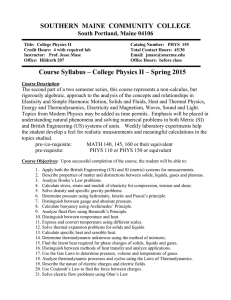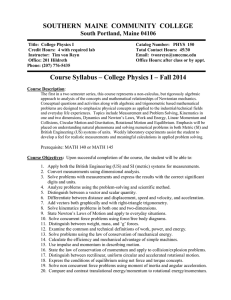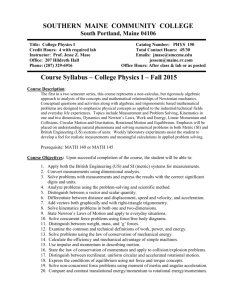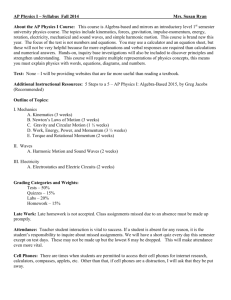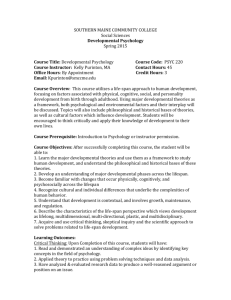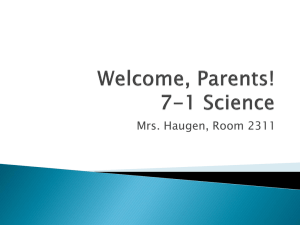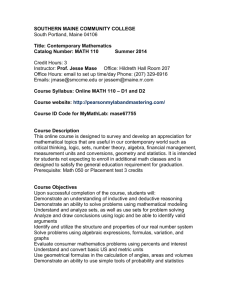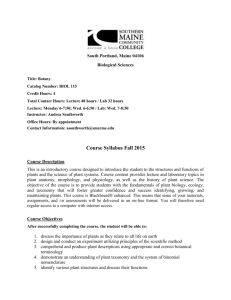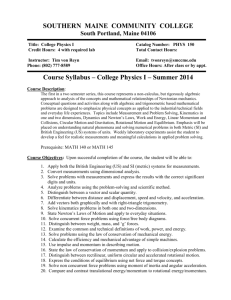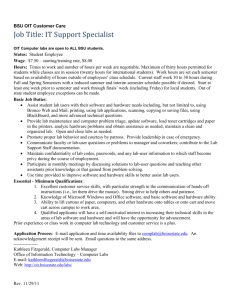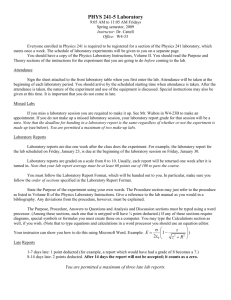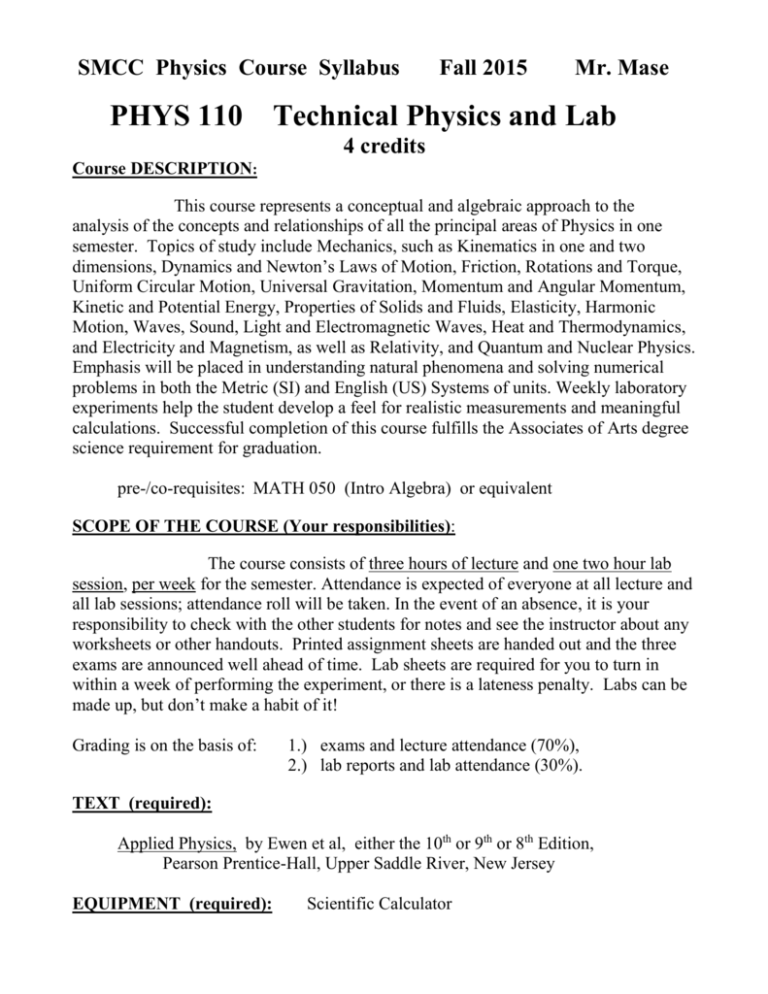
SMCC Physics Course Syllabus
PHYS 110
Fall 2015
Mr. Mase
Technical Physics and Lab
4 credits
Course DESCRIPTION:
This course represents a conceptual and algebraic approach to the
analysis of the concepts and relationships of all the principal areas of Physics in one
semester. Topics of study include Mechanics, such as Kinematics in one and two
dimensions, Dynamics and Newton’s Laws of Motion, Friction, Rotations and Torque,
Uniform Circular Motion, Universal Gravitation, Momentum and Angular Momentum,
Kinetic and Potential Energy, Properties of Solids and Fluids, Elasticity, Harmonic
Motion, Waves, Sound, Light and Electromagnetic Waves, Heat and Thermodynamics,
and Electricity and Magnetism, as well as Relativity, and Quantum and Nuclear Physics.
Emphasis will be placed in understanding natural phenomena and solving numerical
problems in both the Metric (SI) and English (US) Systems of units. Weekly laboratory
experiments help the student develop a feel for realistic measurements and meaningful
calculations. Successful completion of this course fulfills the Associates of Arts degree
science requirement for graduation.
pre-/co-requisites: MATH 050 (Intro Algebra) or equivalent
SCOPE OF THE COURSE (Your responsibilities):
The course consists of three hours of lecture and one two hour lab
session, per week for the semester. Attendance is expected of everyone at all lecture and
all lab sessions; attendance roll will be taken. In the event of an absence, it is your
responsibility to check with the other students for notes and see the instructor about any
worksheets or other handouts. Printed assignment sheets are handed out and the three
exams are announced well ahead of time. Lab sheets are required for you to turn in
within a week of performing the experiment, or there is a lateness penalty. Labs can be
made up, but don’t make a habit of it!
Grading is on the basis of:
1.) exams and lecture attendance (70%),
2.) lab reports and lab attendance (30%).
TEXT (required):
Applied Physics, by Ewen et al, either the 10th or 9th or 8th Edition,
Pearson Prentice-Hall, Upper Saddle River, New Jersey
EQUIPMENT (required):
Scientific Calculator
Objectives
1. The student will be able to apply physics concepts to
everyday life in the following areas as covered in lecture.
2. The student will be able to use formulas and solve problems in
the following areas as covered in lecture:
1. Introduction
Quantities & Units; Conversions from one system to another
2. Kinematics:
Motion in One Dimension - Position, Velocity, Acceleration
3. Kinematics:
Vectors and Two-Dimensional Motion - Projectiles
4. The Laws of Motion:
Inertia; Weight and Mass; Force; Gravitation; Friction
5. Uniform Circular Motion:
Centripetal and Centrifugal Forces
6. Work and Energy:
Kinetic, Potential, Conservation of Mechanical Energy; Power
Nuclear Energy; Fission & Fusion; E = mc2
7. Momentum, Impulse, Collisions and Conservation of Momentum:
One and Two Dimensions
8. Objects at Rest and Rotational Kinematics and Dynamics
Statics; Torque; Rotational Inertia
9. Elasticity, Stress and Strain, Strength of Materials;
Simple harmonic Motion; Pendulums; Resonance
10. Fluids: Five States of Matter; Density; Buoyancy; Pressure;
Properties of Static Fluids; Fluids in Motion
11. Thermal Expansion of Solids, Liquids and Gases;
Kinetic Theory of Gases; the Gas Laws
12. Heat; Calorimetry; Capacity; Changes of State
Methods of Heat Transfer; Insulation
13. The Four Laws of Thermodynamics; Entropy
Heat Engines and Heat Pumps; Efficiency
14. Vibrations, Waves and Sound; Frequency and Wavelength
Intensity, Reflections and Resonance
Decibels and the Doppler Shift
15. Light: Reflection, Refraction and Dispersion;
The Infinite Spectrum of Electromagnetic Waves
Inverse Square Law and Snell’s Law of Refraction
16. Modern Physics: Atomic, Quantum, Nuclear, and Particle Physics
Astrophysics, Relativity and Cosmology
INSTRUCTOR: Prof. Jesse Z. Mase, Physics and Math Departments
Office Hours – before lectures and after labs is best or email to set time
Hildreth 207, 207-329-6916, e-mails: jmase@smccme.edu
jessem@maine.rr.com
Useful things to note:
1.) Attendance is taken in lectures and labs; you get a “1” if you are
present, and a “0” if you are not. For an attendance grade, if you are
present for thirty seven out of forty five classes, your attendance grade
is 37/45 which is 0.82 or 82%.
2.) Take good notes in lecture and labs by writing down what I write on the
board. This is your single best way to get and organize the information
you need to succeed in this course. My examples are carefully chosen.
3.) Lab sheets which become your lab report are handed out in the lab
periods. They can be filled out completely in the lab period, or you
have up to a week to finish and turn them in. Afterward there is a
lateness penalty.
4.) Worksheets on each unit are provided with solutions. It is in your best
interests to work these problems because the worksheets are made of
old exam questions!
5.) Bring your own calculator to all labs and exams. Learn to use it for
exponents, scientific notation, logarithms and trig functions (I can help
you). You are not going to do well if you try to take an exam without a
calculator! Your phone calculator may be sufficient, if it has the above
functions on it.
6.) You may bring a sheet of notes to an exam. A standard 8.5 x 11 sheet
of paper with notes in your own handwriting on both sides will prevent
you having to memorize anything for exams. Do not let that lull you
into a false sense of security. You still have to study, review your class
notes, make your sheet of notes, master using your calculator and
practice the worksheet questions to prepare!
Lab Experiments - we will do as many of these experiments as
possible, although not necessarily in this order.
Objectives
1
2
3
4
5
6
7
8
9
10
11
12
13
14
15
16
17
18
19
20
21
The student will be able to:
a.) Perform laboratory experiments with oral or written
instructions.
b.) Use formulas and do accurate calculations for the
experiments
c.) Fill out the data and calculations sheets for the experiment,
according to the instructions and sheets given in class.
Measurement, Volume and Density
The Simple Pendulum
Acceleration of Gravity
The Force Table
The Lever
The Egg Drop
Standing Transverse Waves on a String
Acoustic Resonance - Speed of Sound
The Inverse Square Law
Reflection and Refraction of Light
The Great Horsepower Race
Archimedes’ Principle
Projectile Motion
Pulleys and Mechanical Advantage
The Inclined Plane
Torque and Equilibrium
Absolute Zero Calculation
Thermal Conductivity
Heat of Fusion of Ice
Heat of Vaporization of Steam
Newton’s Law of Cooling –
the Half Life of Temperature Change
SMCC Policies to Note:
End-of-Course Evaluation
In order to gain access to final course grades, students must complete evaluations for each course attended at
SMCC. Evaluations are submitted online and can be accessed through the student portal site. Students can
access the course evaluation report beginning two weeks before the end of classes. The deadline for submission
of evaluations occurs 24 hours after the last day of classes each semester. Instructors will announce when the
online course evaluation is available.
ADA Syllabus Statement
Southern Maine Community College is an equal opportunity/affirmative action institution and employer. For
more information, please call 207-741-5798.
If you have a disabling condition and wish to request accommodations in order to have reasonable access to the
programs and services offered by SMCC, you must register with the disability services coordinator who can be
reached at 741-5629. There will be some documentation for your teachers that must be supplied before
accommodations can be given. Further information about services for students with disabilities and the
accommodation process is available upon request at this number.
SMCC Pay-for-Print Policy
Students can print 100 pages per semester for free. If you print over 100 pages, you will be charged 10 cents per
page to your Beacon Bucks account. Left-over pages will roll over to the following semester but will zero out at
the end of the academic year. A pilot project tracking public printing has shown that this amount of free printing
meets the needs of the vast majority of students. The College’s pay-for-print system monitors printing on all
public printers (i.e., those in general access labs, library printers, the LAC, and technology labs). Each time you
log in to the system, the print station displays the remaining print quota. Once the printing quota has been
exceeded, users will be charged $0.10 per page on their Beacon Bucks accounts. Color printouts will be charged
at 11-page units. This means each color printout will count as 11 pages toward the quota and cost $1.10.
Students can add money to their cards using a credit card online.
Add-Drop Policy
Students who drop a course during the one-week “add/drop” period in the fall and spring semesters and the first
three days of summer sessions receive a 100% refund of the tuition and associated fees for that course. Please
note any course that meets for less than the traditional semester length, i.e., 15 weeks, has a pro-rated add/drop
period. There is no refund for non-attendance.
Withdrawal Policy
A student may withdraw from a course only during the semester in which s/he is registered for that course. The
withdrawal period is the second through twelfth week of the fall and spring semesters and the second through
ninth week of twelve-week summer courses. This period is pro-rated for shorter-length courses. To withdraw
from a course, a student must complete and submit the appropriate course withdrawal form, available at the
Enrollment Service Center (no phone calls, please). The designation “W” will appear on the transcript after a
student has officially withdrawn. A course withdrawal is an uncompleted course and may adversely affect
financial aid eligibility. Failure to attend or ceasing to attend class does not constitute withdrawal from the
course. There is no refund associated with a withdrawal.
Plagiarism Statement
Adherence to ethical academic standards is obligatory. Cheating is a serious offense, whether it
consists of taking credit for work done by another person or doing work for which another person will
receive credit. Taking and using the ideas or writings of another person without clearly and fully
crediting the source is plagiarism and violates the academic code as well as the Student Code of
Conduct. If it is suspected that a student in any course in which s/he is enrolled has knowingly
committed such a violation, the faculty member should refer the matter to the College’s Disciplinary
Officer and appropriate action will be taken under the Student Code of Conduct. Sanctions may
include suspension from the course and a failing grade in the course. Students have the right to appeal
these actions to the Disciplinary Committee under the terms outlined in the Student Code of Conduct.

